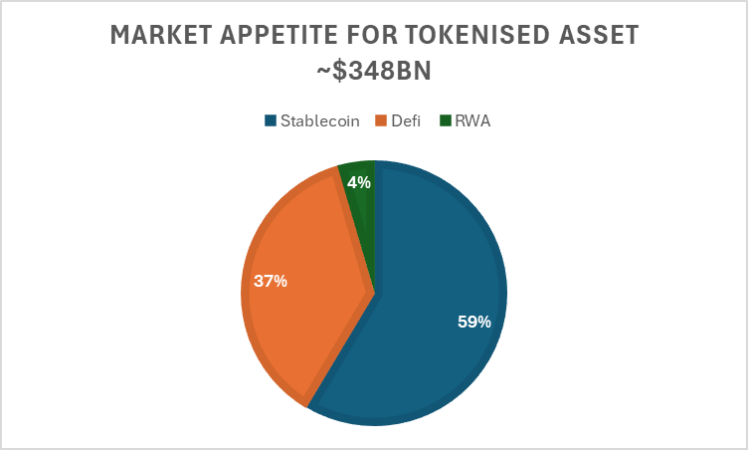Why Institutions are Flocking to Digital Assets: a Perspective
Over the past decade, digital assets have transformed from a fringe concept to the cornerstone of a new financial paradigm. Here's why institutions are flocking to this space, and what custodians can do to guide them through.
by Gary Murphy, Product Manager, Zodia Custody
Over the past decade, digital assets have transformed from a fringe concept to the cornerstone of a new financial paradigm. What started with Bitcoin’s whitepaper in 2008 has evolved into a vast ecosystem reshaping how institutions think about investments, efficiency, and innovation. The story is no longer just about Bitcoin or even crypto as an asset class – it’s about blockchain becoming the foundational infrastructure for Finance 2.0. Here’s why institutions are flocking to this space, and what custodians can do to guide them through.
From Bitcoin to blockchain rails: a macro transformation
Bitcoin may have started as “digital gold,” but the evolution of blockchain technology has propelled it into the mainstream. Today, it’s not just about holding BTC; it’s about leveraging blockchain to create efficiencies traditional finance (TradFi) could only dream of. Institutions are no longer merely experimenting – they’re building. From asset tokenisation to decentralised finance (DeFi), blockchain technology has become the enabling force for a more democratised and efficient financial system.
Consider this: companies like MicroStrategy (MSTR) in the US and Metaplanet (3350.T) in Japan are reaping the benefits of integrating Bitcoin into their corporate treasuries. These firms, which were up 375%1 and 2,239%2 in 2024 respectively, show how early adoption can lead to significant upside. As institutions start to diversify their treasuries, the need for trusted partners to provide secure infrastructure is paramount.
Meanwhile, Bitcoin itself continues to prove its resilience, up 121%3 in 2024. But institutions aren’t stopping at BTC – they’re exploring the broader digital ecosystem to diversify and innovate.
The new frontier: from stablecoins to Finance 2.0
What’s driving this institutional migration?
It’s the realisation that blockchain isn’t just an asset class, it’s the infrastructure of a new financial system. Institutions are leveraging a Macro Transformation that includes:
- Stablecoins: Stablecoins, pegged to real-world assets like the US dollar, offer stability in the volatile crypto market. They’ve become critical tools for cross-border payments, liquidity management, and even payrolls. Think of them as the rails for global money movement, bypassing the inefficiencies of traditional banking systems.
- Money Market Funds (MMFs) and DeFi: Decentralised finance is unlocking access to yield opportunities once reserved for the few. As of Dec 2024, the total value locked (TVL) in DeFi platforms is $125 billion, reflecting significant growth compared to $0.5 billion in Jan 2020. Money Market Funds built on blockchain are offering higher returns, faster settlements, and more transparency. Institutions are tapping into these decentralised rails to complement their TradFi strategies.
- Tokenised assets: From fractionalised real estate to tokenised equities and bonds, blockchain is opening new avenues for investment. These assets reduce barriers to entry, improve liquidity, and make global markets more accessible. In essence, they’re democratising capital markets.
 Blockchain has fulfilled TradFi’s long-standing aspiration of creating transparent, efficient, and global financial systems. This evolution is why institutions no longer view digital assets as a speculative opportunity but as the foundation of Finance 2.0.
Blockchain has fulfilled TradFi’s long-standing aspiration of creating transparent, efficient, and global financial systems. This evolution is why institutions no longer view digital assets as a speculative opportunity but as the foundation of Finance 2.0.
The challenge: trust and scalability
Despite this opportunity, institutional adoption comes with hurdles. Security, regulatory clarity, interoperability and scalability remain key concerns. Adding new digital assets to a custodial offering requires rigorous due diligence and operational excellence – not all custodians can keep up.
Navigating the digital asset revolution with confidence
Institutional adoption of digital assets hinges on secure infrastructure, thorough due diligence, and adaptability to emerging trends. Here are some key considerations for custodians supporting this transformation:
- Comprehensive asset coverage: Institutions require access to a broad spectrum of digital assets, from leading cryptocurrencies like Bitcoin and Ethereum to innovative tokens across ecosystems such as ERC-20 and SPL. Custodians with extensive market cap coverage ensure that investors can diversify and innovate without limitations.
- Rigorous due diligence: A robust asset vetting process is critical to institutional confidence. Custodians must prioritise stringent security and legitimacy checks for every supported asset, mitigating risks in an evolving landscape.
- Adapting to emerging assets: As blockchain innovation accelerates, custodians are tasked with supporting groundbreaking assets like Kaspa (a haven for Bitcoin miners) and tokens from The Open Network (enabling use cases like payments within messaging platforms). Tokenised assets, such as those enabled by Polymesh, are also reshaping how institutions engage with real-world assets.
- Future-ready scalability: The rapid expansion of blockchain technology calls for custodial infrastructure capable of handling new developments, from next-generation Layer 1 blockchains like the unconventional Berachain. Institutions need scalable solutions to stay ahead of the curve.
The bottom line: from fringe to foundation
The digital asset landscape is no longer about speculative bets.
It’s about building the future of finance. Institutions that adopt digital assets today are positioning themselves as leaders in the next wave of innovation, and they need a trusted guide to navigate the risks, capitalise on opportunities, and fully embrace the potential of Finance 2.0. Partnering with experts who prioritise security, scalability, and innovation is essential to thrive in this rapidly evolving landscape.
Blockchain is no longer just an asset class – it’s the rail system for a global, democratised financial future.
References:
- FinanceCharts MSTR Stock
- TradingView as of 31/12/2024
- TradingView as of 12/12/2024
Disclaimer: This article is provided to you for your information and discussion only, and represents the views of the individual. It should not be regarded as a solicitation or an offer to buy or sell any products or services in any country to any person to whom it is unlawful to make such an offer or solicitation. Virtual Assets may lose their value in full or in part and are subject to extreme volatility, and the owner and/or investor in the Virtual Asset can lose all the money or other value they invest, and does not benefit from any form of financial protection. View full disclaimer here: zodia-custody.com/marketing-disclaimer.
Share article:
Frequently Asked Questions
Why are institutions increasingly investing in digital assets?
Institutions are recognising that blockchain is not just a new asset class — it’s the infrastructure for Finance 2.0. Beyond Bitcoin, blockchain enables efficiencies in settlement, liquidity, and transparency that traditional finance has long sought. The shift from experimentation to adoption reflects a growing belief that digital assets are now a core part of the global financial system, not a speculative side market.
How has the perception of Bitcoin and blockchain evolved?
Bitcoin began as “digital gold,” but blockchain technology has since evolved into a mainstream financial foundation. Companies like MicroStrategy and Metaplanet have demonstrated the institutional benefits of BTC treasury strategies, while broader adoption across stablecoins, tokenised assets, and DeFi shows that blockchain’s real value lies in building a new financial infrastructure, not just holding crypto.
What are the main forces driving institutional migration to blockchain?
Institutions are embracing blockchain for its efficiency, accessibility, and innovation potential.
Key drivers include:
- Stablecoins — powering fast, transparent, cross-border payments.
- DeFi and tokenised money market funds — offering yield and liquidity with blockchain-level transparency.
- Tokenised real-world assets — improving accessibility and efficiency in capital markets.
Together, these trends mark a shift toward a programmable, interoperable financial system.
What challenges do institutions face in digital asset adoption?
While opportunity is vast, institutions still grapple with issues like security, regulatory clarity, interoperability, and scalability. For custodians, the challenge lies in conducting rigorous due diligence on new assets, maintaining robust operational frameworks, and ensuring secure integration across multiple blockchain networks.
How are custodians enabling institutional participation?
Custodians act as the bridge between innovation and trust. They provide the infrastructure to safely hold, manage, and transact digital assets across diverse networks. Leading custodians prioritise:
- Comprehensive asset coverage across major protocols.
- Vetting and risk assessment for every supported token.
- Scalability to support next-generation blockchains and tokenised instruments.
This infrastructure allows institutions to innovate confidently and compliantly.
What does the future of institutional digital asset adoption look like?
Digital assets have moved from fringe to foundation. As blockchain continues to underpin global finance, institutions will focus on building sustainable strategies around tokenisation, stablecoins, and DeFi. Success will depend on partnering with trusted custodians that combine security, scalability, and innovation – enabling institutions to lead in the era of Finance 2.0.
Stay up-to-date
Sign up for the latest news, research and events from Zodia.

Get in touch
Our friendly team is always here to chat







